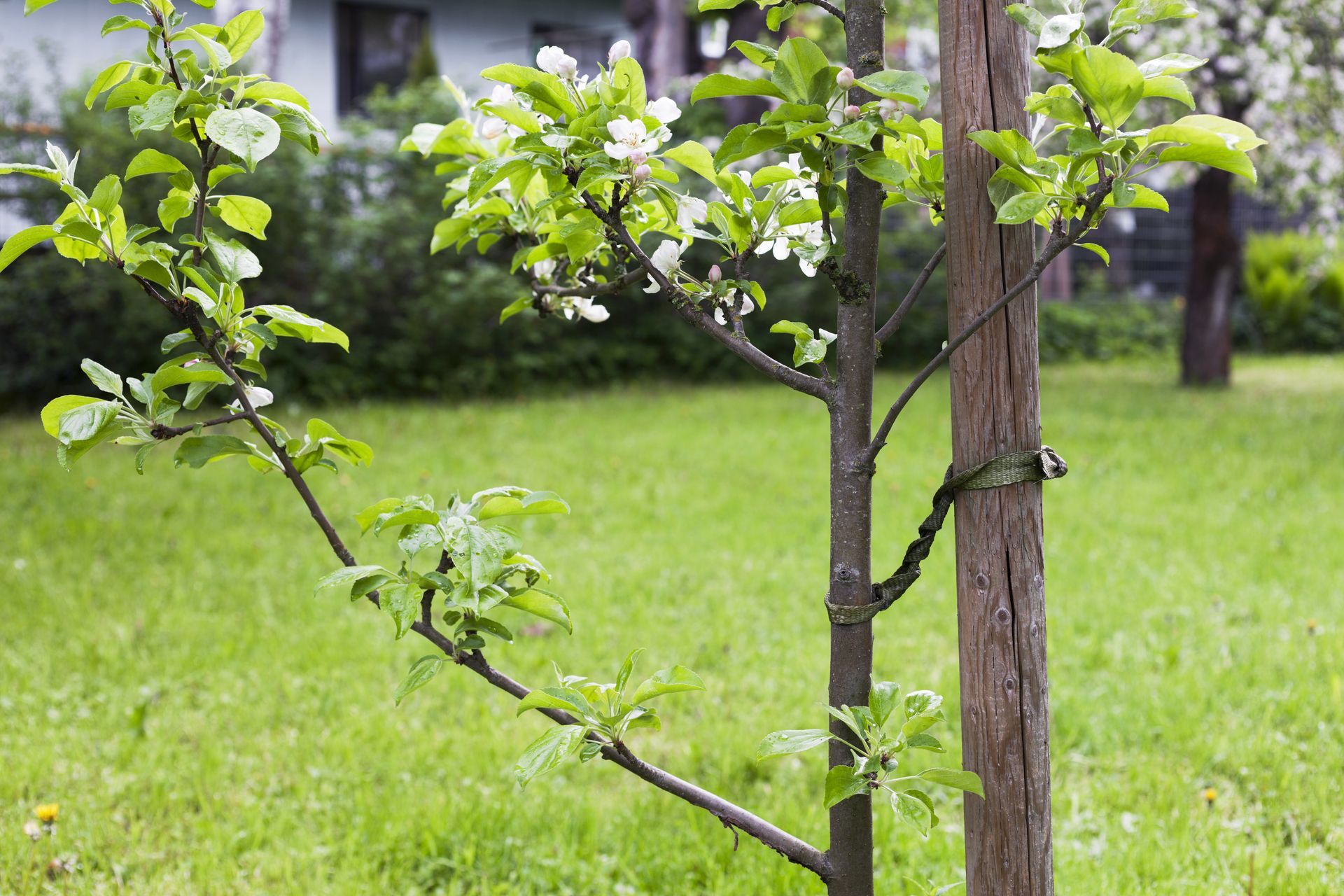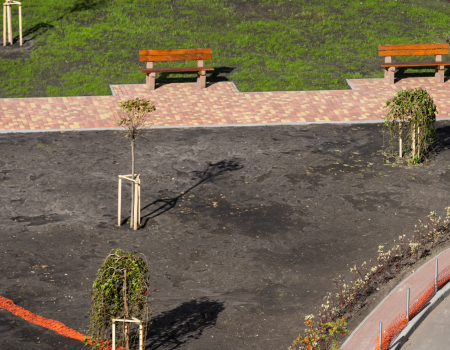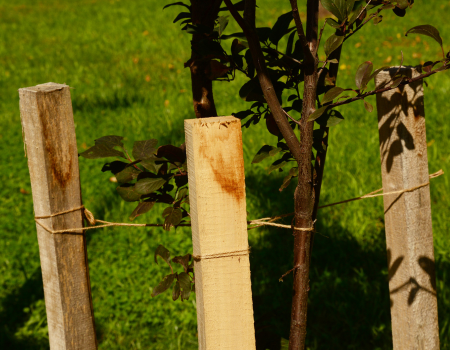How To Stake A Tree: The Complete Guide

Here's how to stake a tree.
Proper staking evaluation of the tree's height, trunk diameter, age, species, etc.
When you learn what kind of tree you are dealing with, you will usually stake a tree with one of the three staking methods.
We cover all that and more below.
Table of Contents
TL;DR: If you don't feel like reading about tree stakes and just want to know what is a good set, check out this set. Should cover most needs for young saplings.
Staking Trees
Staking trees is a controversial topic in the tree world that always begs the question: to stake or not to stake.
Staking, like anything, has pros and cons you need to consider before making your final decision.
Typically one to three stakes are used to stabilize a young tree sapling.
Also, you'll often see staking for a leaning tree.
But we'll give you the rundown on the three different methods for staking your tree.
What Are Tree Stakes?
Tree stakes are anything used to hold up young or leaning trees. They can be:
- Metal Stakes
- Wooden Stakes
- Wire Stakes
- Rope Stakes
Stakes help a tree get established in the case of large amounts of prevailing wind.
Tree stakes help a tree's growth if it can't grow on its own.
Three Tree Staking Methods
Standard staking methods include one, two or three stakes.
The breakdown is simple:
- Single Staking
- Double Staking
- Triple Staking
Proper staking means giving the tree enough support to get through the early years of its life.
Anything more than that, and you risk damaging the tree.
Single Staking
You can stake a young tree with one staking stick if tree is small enough.
You simply get a stake that is shorter than the length of the tree and attach the tree to the stake while also being sure not to dig the stake too deep into the ground.
For example, if the tree is 7 ft. tall, you buy a stake for 3 to 5 ft. tall and tie the tree to the stake as low as practically possible.
Drive the stake into the ground so it crosses the tree trunk at an angle about a foot above the ground.
Using a soft cord, string or staking straps, tie the string so that the tree isn't rubbing up against the stake.
You need to loop the string around the trunk, cross it, then loop it again around the stake, creating a soft barrier between the trunk and the steak.
Warning: Please do not use anything abrasive like wire or chains. These can easily damage the tree trunk. We figured we didn't need to say this, but you wouldn't believe what you see out in the field.
All too often staking material is left on the tree. After the first growing season, remove any support stakes or guy wires left on the tree to avoid girdling the tree.
Double Staking
If two stakes are used, then a single strip of soft or flexible material tied at the top of each stake should be sufficient for support.
Again, use stakes that are roughly shorter than the height of the tree, and firmly stake them into the ground (without damaging any roots).
For double stakes, place them about 3 ft. away from the tree on opposing sides.
Again, use a soft material, something like canvas or straps. Be sure to leave a little bit of slack on the lines.

Triple Staking
Trees larger than 8 ft. tall usually require triple staking.
It's a similar story to double staking, just with one more stake and a bigger tree.
Space the tree stakes an even length apart around the tree or planting hole.
The length apart from the tree should be for every foot of height between the ties and the lower limbs, that is the amount of space between the stakes and the tree.
If you are attaching ties to branches 5 ft. above the ground, plant the stakes 5 ft. away from the tree.
The stakes go into the ground at an angle, with about 6 inches left above the ground.
Use non-abrasive material or coat any wire you use with a soft or rubber garden hose material where it connects to the bark of the tree.

Stabilizing Trees With Guy Wires
Newly planted trees larger than 4 in. in diameter are sometimes stabilized with guy wire that is sheathed in plastic sleeves.
Place the guy wires lower on the trunk because you want the top of the tree to be able to move freely so the tree can develop taper while maintaining that much-needed root ball stability.
Warning: Do not attach any guy wire above the top two-thirds of the tree height.
The higher the support on the tree, the more upright and inflexible the top of the tree will become.
Any guying materials that you use should be wide, flexible, nonabrasive, and smooth.
Anything you can do to reduce girdling and friction will minimize the damage done to the tree.
If you stabilize your tree, do it as low as possible on the trunk while remaining practical. Ties should be broad and smooth. Be sure to buy ties that are somewhat elastic.
How Often To Check Your Stakes
You'll want to check your stakes often during that first year/growing season.
You want to make sure the supports have the right tension and aren't hurting the tree in any way.
You should remove the stabilization stakes after the first growing season because if they are left on for more than a year, the tree's ability to stand alone will be diminished.
If your tree grows up and can't stand on its own, you'll be using tree loppers for the fallen branches and maybe even a chainsaw for the deadwood. Avoid.
Root Ball Anchoring
Root ball anchoring is an alternative stabilization method for some tree species.
It allows for increased trunk movement in the wind compared to staking but also maintains support for the root ball.
Anchoring the root system eliminates the risk of trunk damage that staking or guying materials often causes.
Anchoring is suitable for two types of trees:
- Soil-ball
- Container-grown trees
Most of the time, trees will come with instructions for anchor installation.
Be sure to follow the manufacturer's recommendations.
Should You Stake A Tree?
Staking your trees is not always needed, and in some cases can harm the tree's health and development.
Compared to trees that have not been staked, staked or young trees that have been supported for long periods have less trunk taper, smaller root systems, and sometimes break, topple, or tip after removing the stakes.
Not only that but stabilized trees can even be injured or girdled by the staking materials.
Trunk tapering is when a tree should be thicker at the base of the tree then at the top of the tree. Proper trunk taper will stabilize the tree, supporting it in harsher, windier climates.
Why Some People Stake Their Trees
If you are a professional arborist, a lot of times clients will want to include staking their trees in planting specifications.
If you are an arborist and your client wants a tree steak, be sure to set the expectations around staking needs, and the potential negative side effects it can have on the tree.
Some trees cannot stand upright without some supporting mechanism, including:
- Bare-root trees
- Young trees grown in small containers with loose potting
- Containerized trees with large crowns
- Balled-and-burlapped trees without wire
- Large conifers (especially in windy areas)
Another reason that young trees could need staking is to reduce root ball movement.
Root ball movement causes damage to the root system that absorbs the nutrients for the tree.
Sweet New Earth's Final Word
While we recommend avoiding staking a young tree if you can, if you can't you need to do it right!
If you have never staked a tree before, be sure to contact your local tree care professional to get the advice you need.
Tree staking can be a complicated process. In most cases, if you have a leaning tree, you should ask a professional.
If you choose to stake your tree yourself, be sure to regularly check on both the tree and the stakes.
You want to make sure you aren't damaging the tree in any way so that it can grow to be the healthy tree you want for your landscape.
FAQs
Before you go...
Now that you know how to stake a leaning tree, or a young tree sapling, you are ready to read more in-depth tree guides.
We cover everything from tree care, fertilizer, planting trees on slopes, and more. Be sure to check out our guide:
Related Articles:

Christina Hernandez
Christina has done most of her research on environmental science but recently has changed her focus towards sustainable forestry. She has a passion for the outdoors and wants to spread that passion to the world.
Join our community!
Join to receive guides, insights, and the latest gardening deals!
